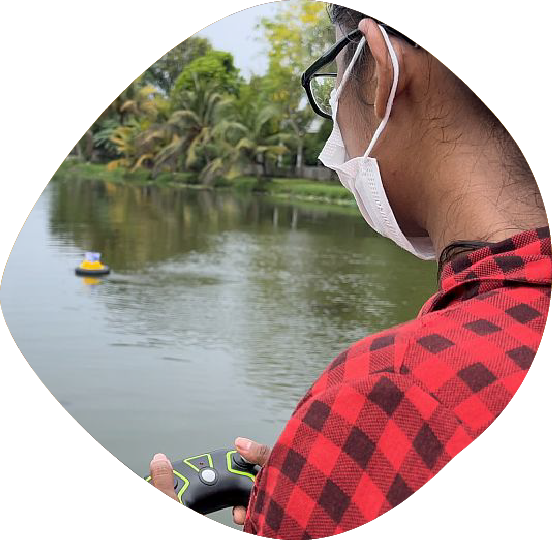 BIG PICTURE STORY
BIG PICTURE STORY
Simplification of complex environmental tools enables widespread use in South Asia
Data science and digital innovation are needed to combat water insecurity, which is critical for our food systems. However, creating a highly advanced ‘tool’ will not produce results unless it is accessible, scalable and easy to use by those who need it – whether researchers, decision-makers, farmers, planners or civil society actors.
In South Asia, the International Water Management Institute (IWMI) has developed highly innovative tools that are uniquely suited to different country contexts. In India, a simple tool enables the proper sizing of solar irrigation pumps, while in Sri Lanka, a robot constructed from everyday materials is helping residents monitor and conserve their own resources.
Size is key to solarization
India is a world leader in the solarization of agriculture, with more than 93% of global off-grid capacity installed for use in agriculture in the country. More than 350,000 solar irrigation pumps are already in use, and the Government of India plans to deploy at least 3.5 million more.
Solar pumps shield smallholder farmers from rising diesel prices and generate no carbon emissions, but using a pump of the correct size is crucial to success of the system. Oversized pumps generate excess energy that may be wasted. With no running costs, there is evidence that solar pump owners pump for longer hours than diesel pump owners. This may threaten the sustainability of groundwater resources, especially if pumps are oversized. Undersized pumps fail to meet farmers’ irrigation requirements, creating a poor user experience and risking disadoption.
Additionally, since the costs of installing solar pumps are too high for most smallholder farmers, the government is offering high capital subsidies. Correct sizing of pumps will make the most of these public investments.
With support from Deutsche Gesellschaft für Internationale Zusammenarbeit (GIZ) and in partnership with the Indian Council of Agricultural Research (ICAR) and the Borlaug Institute for South Asia (BISA), IWMI has developed a tool to assist researchers, technical personnel, farmers, planners and decision-makers to select the optimum pump size for each solar irrigation adopter. This tool was created using Microsoft Excel, which is widely available and can function offline, allowing use of the tool in areas with poor internet connectivity.
Secondary datasets on climate, soils and crops are incorporated into the tool, enabling pump sizing at a regional scale. Users can also input their own data to access a pump size specific to their farm(s). This enables calculations at different levels, in data-poor and data-rich environments.
Solar pumps typically last 20–25 years and investment decisions, therefore, must account for future needs. The IWMI-ICAR pump sizing tool enables users to simulate scenarios such as lowering of the groundwater table, a change in the crop cultivated or an adjustment to crop water demand due to rising temperatures caused by climate change.
The beta version of the pump sizing tool has been adopted by India’s Ministry of New and Renewable Energy (MNRE) for use in its ambitious solarization campaign, Pradhan Mantri Kisan Urja Suraksha evam Utthan Mahabhiyaan (PM-KUSUM). IWMI has committed to supporting the Government of India in further refining this tool, incorporating feedback from the growing number of users. A mobile phone app and online versions are now in development.
The sizing tool is being replicated by IWMI in Nepal through the CGIAR Initiative on NEXUS Gains and as part of a collaborative project with GIZ titled Solar Energy for Rural Livelihoods (SE4RL). There is also demand for developing a similar tool for Bangladesh. It is hoped that the tool can be scaled and replicated for use in other countries in Asia and Africa, maximizing the potential of solar irrigation for a greener future.
 Residents and robots collaborate to monitor wetlands
Residents and robots collaborate to monitor wetlands
Wetlands can, in some instances, reduce flood risk, enhance biodiversity and provide multiple additional ecosystem services. However, global wetlands are disappearing three times faster than rainforests, making them one of our most threatened ecosystems.
Urban wetlands can provide vast benefits. The Colombo Wetland Complex, which sits amid the sprawl of the Sri Lankan capital, directly benefits 60% of the city’s households, creating livelihoods and contributing to the food system, with products including fish and rice. Indirect benefits include flood protection, pest regulation and climate cooling. Since the 1980s, 60% of the complex has been lost. Infilling, waste dumping and dredging have resulted in a shrinking ecosystem with poor water quality, threatening its flora and fauna. The Government of Sri Lanka recognizes that urgent action is needed to conserve this vital habitat.
Given the community’s dependence on the wetlands, fostering local ownership of any conservation initiative is essential to its success. In recognition of this, IWMI has co-developed Float: a low-cost, easy-to-build robotic device that communities can use to monitor the water quality of the wetlands. Float can cruise, unmanned, through the wetlands to collect and report real-time dissolved oxygen, pH and water temperature. These are all indicators of wetland health.
Design Engineering student Luisa Charles worked with IWMI and other partners to create Float as one component of the Increasing the resilience of biodiversity and livelihoods in Colombo’s wetlands project, funded by the Darwin Initiative. Luisa collaborated with local engineering students, wetland communities and other partner organizations, and held workshops to gain feedback from potential users. Crucially, the basic version of Float can be built with readily available materials – such as a pressure cooker gasket – and the code used is open source.
Luisa is now working with a local nonprofit organization to design a mobile phone application which will enable users to input data collected by the device, as well as observations such as the color of the water or signs of dredging.
Luisa’s work focuses on human psychology and behavior. Float has been designed with communities in mind, so she is keen to understand which features will encourage the greatest adoption of the device. Will communities use Float once it is available to them? Is it intuitive enough to not require a user manual?
Enabling both communities and researchers to monitor the water quality of the wetlands they depend on will provide a better understanding of this ecosystem at all levels of society. This, in turn, supports the conservation and health of these important ecosystems and the vital services they provide.
We gratefully acknowledge the German Agency for International Cooperation (GIZ) and Department for Environment, Food and Rural Affairs (DEFRA) for their respective contributions to the pump sizing tool and Float innovations.
